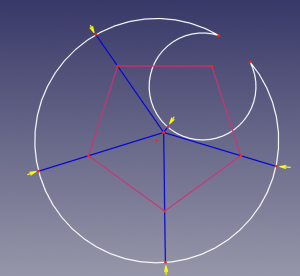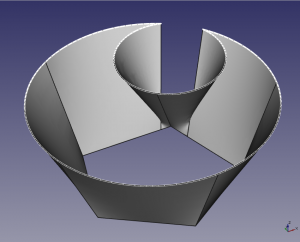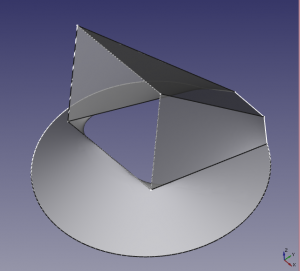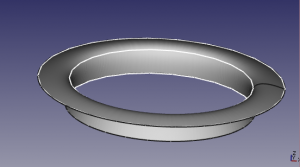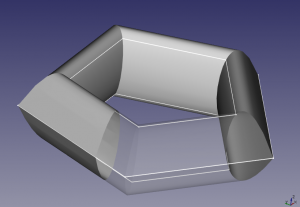Part Loft Technical Details/ro: Difference between revisions
No edit summary |
No edit summary |
||
| Line 38: | Line 38: | ||
===Pasul 3. Making the loft surface.=== |
===Pasul 3. Making the loft surface.=== |
||
[[File:Loft B-spline.png|thumb|400px|A spline interpolation curve (red) that follows the loft surface. The points to interpolate through are shown as red squares.]] |
[[File:Loft B-spline.png|thumb|400px|A spline interpolation curve (red) that follows the loft surface. The points to interpolate through are shown as red squares.]] |
||
Dacă există doar două profiluri, suprafețele create sunt suprafețe riglate între segmentele corespunzătoare ale profilurilor. Muchiile/marginile drepte sunt create pentru a conecta vârfurile corespunzătoare ale profilurilor. |
|||
If there are only two profiles, the surfaces created are ruled surfaces between corresponding segments of the profiles. Straight edges are created to connect corresponding vertices of the profiles. |
|||
If there are more than two profiles, the surfaces are made of splines in the same manner as straight lines form ruled surfaces. The imaginary splines the surface is "made of" are drawn through corresponding points of the corresponding segments of the profiles. |
If there are more than two profiles, the surfaces are made of splines in the same manner as straight lines form ruled surfaces. The imaginary splines the surface is "made of" are drawn through corresponding points of the corresponding segments of the profiles. |
||
Revision as of 10:07, 31 October 2018
Această pagină explică în detalii cum este creată o suprafață Loft. Aceasta este un caz particular de suprafața baleiată Part Sweep dar creată de-a lungul unei traiectorii drepte, dar sunt și alte diferențe.
Informațiile furnizate sunt specifice implementării și se pot schimba. Starea actuală este relevantă pentru FreeCAD 0.15.4119, versiunea OCC: 6.7.0.
Etapele creării suprafeței riglate Loft
Pentru a explica procesul de mansardare, este convenabil să-l împărțim în etape:
- faceți ca numărul de segmente din profiluri să fie egal (dacă acestea nu sunt deja)
- stabiliți corespondența între segmente
- face suprafața mansardei
pasul 1. Faceți ca numărul de segment din profiluri să se potrivească
Instrumentul Loft-ul are nevoie de numărul de segmente să se potrivească pentru a crea suprafețe între segmentele corespunzătoare. Dacă numărul de segmente se potrivește în toate profilurile, acest pas poate fi/este omis.
Dacă cel puțin unul dintre profile are un număr diferit de segmente, se aplică următoarea procedură. Procedura este explicată aici pentru cazul a numai două profiluri pentru simplitate.
- profilurile sunt aliniate temporar, astfel încât acestea să fie coplanare și să se potrivească centrele lor de masă.
- (vezi imaginea) pentru fiecare vârf dintr-un profil, al doilea profil este tăiat la același unghi polar (centrul polar este centrul masei). Dacă există mai mult de o felie posibilă sau nicio felie deloc posibilă (se poate întâmpla pe profile foarte convexe), Loft-ul eșuează în mod obișnuit.
- același lucru se face în sens opus.
Operația este extinsă la toate profilurile, pentru a obține un număr egal de segmente. Numărul total de segmente din fiecare profil ar fi egal cu suma tuturor numerelor de segmente ale tuturor profilurilor (cu condiția ca nici unul dintre vârfuri să nu aibă același unghi polar).
Pasul 2. Establishing correspondence between segments
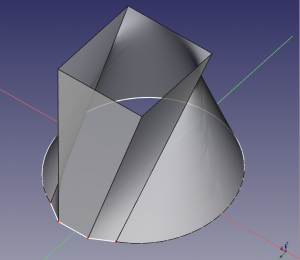
In case numbers of segments in all profiles were not equal, slicing was done in Step 1, and the correspondence is trivial. In case numbers of segments in all profiles were equal, existing segments are used (see the picture), and this is when the correspondence must be established.
Algoritmul exact de a găsi segmente corespunzătoare este complex, dar, în general, tinde să minimizeze răsucirea Loft-ului rezultat. Aceasta înseamnă că, dacă se face o mansardă/loft între două pătrate, este posibilă o răsturnare maximă de <45 °. Rotirea ulterioară a unuia dintre pătrate va face Loft-ul să sară la alte noduri.
Corespondența dintre profilurile învecinate se face independent. Aceasta înseamnă că răsucirea suplimentară poate fi obținută prin adăugarea de mai multe profiluri.
Un alt lucru care trebuie remarcat este că atunci când numărul de segmente în profiluri este egal, loftul rezultat este substanțial mai robust în ceea ce privește profilurile complexe, în special pentru cele ne-convexe.
Pasul 3. Making the loft surface.
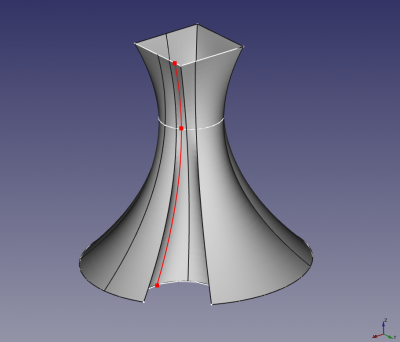
Dacă există doar două profiluri, suprafețele create sunt suprafețe riglate între segmentele corespunzătoare ale profilurilor. Muchiile/marginile drepte sunt create pentru a conecta vârfurile corespunzătoare ale profilurilor.
If there are more than two profiles, the surfaces are made of splines in the same manner as straight lines form ruled surfaces. The imaginary splines the surface is "made of" are drawn through corresponding points of the corresponding segments of the profiles.
The splines are B-spline interpolation.
- If the number of profiles is below 10, interpolation is done with by a B-spline with a maximum possible degree (i.e. degree = number_of_profiles - 1).
- If the number of profiles exceeds 10, the interpolation is switched to 3rd degree B-splines.
The knotting method used is "approximate chord length". Approximate stands for the fact that the knot vector is exactly the same for every spline in a loft. For more info on what is B-spline interpolation, knot vector, chord length method, see, for example, cs.mtu.edu Curve Global Interpolation .
Note that Loft has a "Ruled" property. If it is set to true, ruled surfaces are made between neighboring profiles even when there's more than one profile. That is, B-spline interpolation is replaced by piecewise linear interpolation.
Esența instrumentului
- The loft is doing B-spline interpolation between the provided profiles. The interpolation is switched to piecewise linear when "Ruled" property is set to true.
- When number of profiles exceeds 9, interpolation degree is dropped to 3. This switchover can substantially reduce wiggling.
- Matching the number of segments (aka number of vertices) in the profiles allows one to give the loft a slight twist, and typically permits using more complex profiles.
- When numbers of segments are not matched, it's best to keep the profiles to be representable by a proper r(phi) function in polar coordinates.
Observații suplimentre
- It is not required that the profiles are parallel (see a picture below).
- For Loft, it is not required that the profiles are separated (see a picture below). They can be coplanar, but they should not intersect.
- When "closed" property of the Loft is "true", there is a cusp joint in all the splines forming the Loft (see a picture below). There is no reliable way to close the loft smoothly now.
